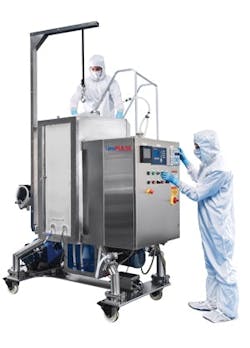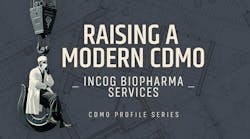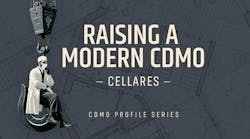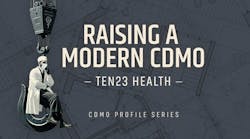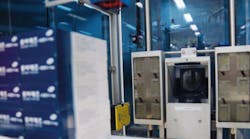During the last six years, single-use systems and devices have emerged as key agents in the biopharmaceutical landscape.¹ Single-use solutions have revolutionized the Pharmaceutical and Biopharmaceutical industry due to their effectiveness in reducing the risks of contamination and allowing faster changeovers. These advantages, coupled with the significantly reduced time and costs required to establish a new manufacturing facility, have made single-use a very popular choice.
Single-use products have gone well beyond an early-stage technology, and it is likely that the popularity of these devices will continue to rise over the next few years.¹ Therefore, it is becoming increasingly important to view single-use system suppliers, not only in the context of “can they make the disposable,” but also from the perspective of “does the single-use system supplier maintain strong quality oversight to support their product from a control process and ensure regulatory compliance.” The recent 10th Annual Report and Survey of Biopharmaceutical Manufacturing Capacity and Production found that 65.7% of end-users of single-use devices agreed use of disposable/single use devices are factors in creating “significant” or “some” improvement to biomanufacturing performance².
Drug manufacturers — especially biopharmaceutical contract manufacturing organizations — must ensure their operations maintain a robust quality systems infrastructure to ensure production efficiency and superior operational excellence thereby driving the continuous improvement cycle. The resulting manufacturing distinction will provide customers with the confidence to withstand regulator scrutiny while providing with certainty that quality products will be available to meet the therapeutic markets demand for its therapies. The manufacture of high-quality single-use systems and process solutions requires the same from its suppliers to minimize risk and ensure safety, traceability and compliance at every stage of production. To minimize risk, single-use system suppliers similarly must control and document each production step from raw materials and assembly to final test, packaging and sterilization.
The FDA’s guidance for single-use system suppliers clearly reinforces the importance of implementing efficient change control procedures as a critical element in an overall quality system.
As a result, change control has become an important factor for the biopharmaceutical industry. Indeed, the FDA’s guidance for single-use system suppliers clearly reinforces the importance of implementing efficient change control procedures as a critical element in an overall quality system, and suggests the scope of a successful change control program must cover a broad set of possibilities, including changes to the supply chain and product specifications or design, as well as upgrades to facilities, utilities, equipment, computer systems, manufacturing instructions, SOPs, test methods and any changes in policy.3
WHAT IS CHANGE?
Change can be defined as a movement out of a current state, through a transition state, to a future state. In biopharmaceutical manufacturing, change can be internally or externally motivated, as well as minor or dramatic departures from what is known, anticipated or unexpected, including alterations to facilities, products, processes, equipment or computerized systems.
Change may be required due to:
• Design and development review, verification, or validation (IQ, OQ, PQ)
• Requests from engineering
• Requests by customers or suppliers
• The need for corrective or preventive action
• Safety and regulatory requirements, and
• Improvements to the function and performance of a product
Effective change control systems take time to establish and must be continuously updated. A mature change control system becomes intuitive and remains relevant. Intuitive in that it fosters a structured approach toward managing and documenting change in an environment that engenders continuous improvement, and relevant in that it stays centered on the objective and nature of pending change, and focused on the exact scope of imminent change.3
Key components of a change control system include3:
• End-to-end communication with all stakeholders from raw materials vendors to product end-users
• Documentation of the details of change, change approvals and implementation, thereby tracking changes effectively for visibility and traceability
• A consistent, structured and sequential approach toward managing change
• An automated system that provides redundant flags/alerts, the ability to search by various criteria, and requires authorization via user credentials in order to make changes
• Routing of change requests to individuals for approvals
• Easy retrieval of information
• Provision of an audit trail
• Demonstration of compliance to FDA regulations
• Speed to allow due deadlines to be met, and
• Education on change control methodology for all employees, to allow timely execution of inventory disposition and existing job orders
Incorporating these key components allows for a dynamic change control system that can help end-users implement continuous improvement and manage impending change with their own products and systems.³
MITIGATING INCONVENIENCE
In particular, a change control system must effectively accommodate supply chain interruptions, as the ability of a single-use system supplier to provide accurate raw materials data is crucial to the quality of high-value products. Raw materials changes are notoriously inconvenient for the end-user, often unavoidable and include changes to component specifications, suppliers and resins.
It’s imperative any change control system accommodate the inevitable and minimize inconvenience to end-users by streamlining provisions for the tracking, reviewing and receiving customer approval of raw materials changes. The system must be flexible so as to allow appropriate, rational documentation of change justifications. Furthermore, the system must extend change control to raw materials vendors, so that the change control procedure can be initiated before the processing of any components impacted by the changes.³
Drug manufacturers must ensure their operations maintain a robust quality systems infrastructure to assure production efficiency and superior operational excellence standards.
CONSISTENT YET FLEXIBLE
ASI fields a structured, consistent, yet flexible change control system. As a fluid-management technology supplier, ASI manufactures single-use systems and bioprocess equipment for the Pharmaceutical, Diagnostic and Biotechnology industries. ASI offers single-use bags with sizes ranging from 50 mL to 5,000 L and inventories more than 900 components as well as more than 80 tubing types and sizes for customized systems.
In its operations, ASI maintains exceptional quality management supporting its products by carefully controlling the manufacturing process. All control processes within the company are centrally coordinated by a customized Enterprise Resource Planning (ERP) software system. This system allows the traceability, document control, quality control and price control essential to implement the strongest quality oversight. It is a fully automated system that provides flags, alerts, the ability to search, and requires chronologically appropriate, timely authorization.
In particular, an appropriate ERP System must coordinate effective change management in the key areas of inventory, compliance, processes, document control and suppliers.
Inventory: Assurance and security of supply. Effective procurement tools ensure existing inventory is managed, and accounts for change that can occur should there be a depletion of inventory or change of raw material or supplier. The best single-use system product features and solutions may become completely useless if a supply of relevant products has not been secured for many years.
An effective Inventory Change Management Program should consider proper inventory control by establishing reordering points, forecasting, safety stock (reserves) programs, material control and inventory reconciliation.
Compliance: The capacity to evaluate change from a regulatory and compliance aspect is critical. In addition, users must be provided with supporting information during change notification so they may determine risk and how a change affects product design.
An effective Compliance Change Management Program must be able to review a change against the established product to ensure the change is equal to or better than the current product and continues to meet customer and regulatory requirements.
An effective Change Management Program must consider regulatory, compliance and vendor requirements.
Processes: Capacity to perform a validation review to ensure changes do not impact processing parameters, or that the integrity of the single-use system is not compromised if processing parameters are impacted.
An effective Process Change Management Program must assess the mechanical attributes of the single-use system and include methods for testing of processes that ensure integrity and performance of products. Key components of a process change management program include but are not limited to a validation of the manufacturing process, assessment of the need for equipment changes and assessment of the bonding properties of various sealing methods.
Document Control: The process should identify the various documents required for change management and have the capacity to review and revise as needed based on an assessment. (Drawings, specifications, operating procedures and test methods.)
An effective Document Change Management Program provides transparency to the changes so there are no surprises when change is implemented. Document change management must ensure that customer specifications are still applicable following a change.
Suppliers: Change agreements, supply agreements and quality agreements ensure the base structure of change management is formed. An effective Change Management Program requires excellent communication between the customer and manufacturer. Agreements should outline the need for proper and timely communication, and assure that no change is implemented prior to notification. Agreements will ensure the manufacturers are aware that any change in the manufacturing, processing, or even the manufacturing location are important enough to be communicated to the customer.
Integrity: Regardless of the ERP systems robustness, the people who interact with the system ultimately assure transparent, reliable communication.
Change control is implemented by the Quality Management System (QMS) according to a well-defined internal ASI procedure that involves responsibility and accountability.
IMPLEMENTED BY QMS
Change control is implemented by the Quality Management System (QMS) according to a well-defined internal ASI procedure that involves responsibility and accountability. Change notifications are logged and maintained under the QMS. ASI’s Engineering Change Order process identifies the items affected by change and the steps required to control how the changes are executed. Examples of such changes include tooling and equipment changes, bill of material changes, product drawing changes, compliance changes, manufacturing routing changes, raw materials changes and process changes. A Raw Material Review Board comprised of key decision makers from the Quality Assurance, Engineering, Purchasing and Inventory Control departments within the organization meet regularly to ensure that the change control system is working effectively and efficiently. All ASI personnel understand the need for and challenges associated with change control. The company’s ERP and QMS are integrated throughout every aspect of its organization and accessible throughout the facility.
Importantly, ASI understands that one of the most critical aspects of change control is end-user change notification. The ability to inform any end-user of change within the product lines they specify requires a very mature Quality System; in ASI’s case, the company maintains 5,000 product codes that support end-user change management communications.
For more than 25 years, ASI’s QMS development has reached a level that ensures complete quality assurance throughout each phase of a product’s lifecycle. The process allows the company to minimize risk, guarantee product quality, deliver safety, traceability, and compliance and provide the highest standard in quality production, assembly, final packaging and sterilization.
ASI’s change control is the most critical element in the company’s quality management system. This is essential, as proper quality systems that maintain control provide key benefits for all stakeholders by improving supplier quality and helping both single-use system suppliers and end-users achieve their business objectives.
References
1 Langer E. Single use technologies changing the biomanufacturing landscape. RAPS Advanced eCTD Submissions Workshop 2012
2 Langer E. Bioplan Associates. Tenth Annual Report and Survey of Biopharmaceutical Manufacturing Capacity/Production, April 2013.
3 Change Control in the FDA-regulated Industry.http://www.metricstream.com/insights/chg_ctrl_FDA.html
